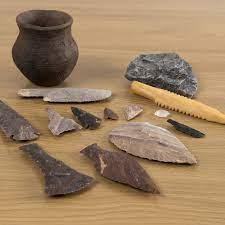

How did daily life change in Britain from the Stone Age to the Iron Age?

KEY VOCABULARY
Chronology - The arrangement of dates or events in the order in which they occurred.
BC - Before Christ. A way of dating years before the birth of Jesus.
AD Anno Domini - “in the year of our Lord”.
Archaeology - The study of the buildings, graves, tools and other objects that belonged to people who lived in the past.
Hunter-gatherers - People who found food from their local environment and then moved from site to site depending on the season. They moved wherever they needed to get food from.
Farmers - The Neolithic or new Stone Age saw the beginnings of agriculture. Animals such as the cow and sheep were domesticated and provided a ready supply of meat, milk, wool, leather and bone. Grain was the first food that could be stored for long periods of time.
Key Questions
1. What was life like in the Paleolithic and Mesolithic?
2. What changed from the Paleolithic to the Mesolithic?
3. What did people eat in the Paleolithic and Mesolithic?
4. How did the search for food change in the Neolithic?
5. What tools were used in the Neolithic?
6. Who were the beaker people?
7. How did tools change after the Neolithic?
8. How did the Bronze Age move into the Iron Age?
9. What are roundhouses?
10. What is a hillfort?

Stonehenge
A prehistoric monument in Wiltshire, England. It consists of a ring of standing stones, with each standing stone around 13 feet high, 7 feet wide and weighing around 25 tons.








Stone Age Tools
1: Palaeolithic (700,000 BCE -10,000 BCE)
There was an ice age during the Stone age and one third of the earth was covered in ice. Archaeologist have discovered that Early humans (Neanderthals and early Homo sapiens) lived at the same time, but Neanderthals became extinct 30,000 years ago.
Early humans arrived in Britain 800,000 years ago. They lived in caves and were nomadic hunter gatherers who moved around seasonally to find food, some hunted animals while others would forage for nuts, berries and shellfish.
They created cave paintings – the Lascaux Caves are famous for hunting scenes and the Cave of Hands for handprints. They developed tools from stone, bone and wood, such as spears and axes, to help with hunting and daily life. Stone tools were made by flint napping stone to make an edge or sharp point.

The Lascaux Caves
2: Mesolithic (10,000 BCE – 4,500 BCE)
During the Mesolithic era, Stone Age people were still nomadic but are thought to have lived in tents made with wood or animal bones and animal skins with a layer of moss, reeds and other soft plant materials for the floor. Fossilised remains of Mesolithic footprints can be seen on the coast of Howick in Northumberland.


3: Neolithic (4,500 BCE– 2,400 BCE)
Farming and the creation of organised settlements was the biggest change in human history. Stone Age people began to settle in villages.
There is evidence of settlements, such as the one at Skara Brae, often made up of simple roundhouses built from stone. They were built into mounds of rubbish known as midden (small stones, shells, mud and animal bones), which would provide stability and insulation. These houses had beds, storage shelves and a fireplace in the middle.
Religion and Trade continued to develop and large round megaliths, like Stonehenge, were built!
Mesolithic footprints on the coast of Howick in Northumberland

Skara Brae, which is older than Stonehenge, is in the Orkney Isles, Scotland.
There are eight stone houses in the village.
